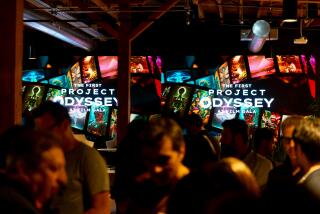LACMA’s ‘Beyond the Infinite’ traces ‘2001’s’ sci-fi influence
- Share via
Stanley Kubrick’s 1968 sci-fi epic “2001: A Space Odyssey” had an immediate impact on filmmakers.
The Los Angeles County Museum of Art’s new series “Beyond the Infinite: Science Fiction After Kubrick,” which begins Friday and concludes April 6, features several cerebral, thought-provoking genre films that were inspired by Kubrick’s masterpiece. “Beyond the Infinite” is one of many recent LACMA film programs that have enhanced the museum’s popular “Stanley Kubrick” exhibition.
Bernardo Rondeau, assistant curator of LACMA’s film programs, noted that science-fiction films have been popular since the beginning of cinema, with such classics as Georges Melies’ 1902 “A Trip to the Moon.”
PHOTOS: Directors go sci-fi at the ‘Beyond the Infinite’ film festival
“But science-fiction films really change with ‘2001,’” he said, because Kubrick “creates this film that truly is quite mystifying — it deals with a lot of ambiguity. It is a visionary experience. The film caught fire with the counterculture because of the ending. I think for people it was quite new and revelatory.”
Some of the films in “Beyond the Infinite,” he noted, “very directly reference Kubrick’s film.” Filmmakers saw “the opportunity for new, more cerebral and more adult films,” using sci-fi stories and themes.
Among the films featured in “Beyond the Infinite” are “Solaris,” Andrei Tarkovsky’s poetic 1972 Russian film about a psychologist who is sent to investigate the emotional condition of three scientists living on a space station; Nicolas Roeg’s 1976 “The Man Who Fell to Earth,” starring David Bowie as a humanoid alien who leaves his dying planet and lands in New Mexico; and Douglas Trumbull’s 1972 directorial debut, “Silent Running.” (Trumbull was the special photographic effects supervisor on “2001.”)
The series opens with a true rarity — Saul Bass’ only narrative feature, 1974’s “Phase IV.” Bass, a graphic designer renowned for his bold poster designs and movie title sequences, directed this thriller about a cosmic event that causes the rise of intelligent ants that kill people and animals alike. The film was restored by the Academy Film Archive and will feature Bass’ original ending.
“This ending was never commercially released,” said the archive’s Mike Pogorzelski. “It was tested for preview audiences and after the first screening it seems that everyone agreed audiences didn’t get it. When you watch the alternate ending, it is a very ambitious visualization. There is no dialogue. It is abstract in a somewhat similar way to ‘2001.’”
Rondeau found the ending “one of the most mind-blowing, spellbinding things that have been committed to film. It is a film that needs to be known.”
The series also features George Lucas’ 1971 feature debut, the futuristic parable “THX 1138,” based on his award-winning USC student film. “It is a fascinating, quite dark, a precise minimalist film,” said Rondeau.
PHOTOS: Behind-the-scenes Classic Hollywood
Though Lucas, said Rondeau, played a major role in this new breed of science-fiction film post-”2001,” he also ended it with 1977’s game-changing “Star Wars.” “Lucas takes [the genre] back into adventure and into more kind of heroic journeys, which these films in the festival are not about. They are more philosophical.”
Several of the films in the series are ripe for rediscovering, noted Rondeau, including Mike Hodges’ 1974 adaptation of Michael Crichton’s “The Terminal Man,” starring George Segal as a modern-day Jekyll and Hyde. The film, shot in various locations in Los Angeles, was not well received upon release.
Critics and audiences also scratched their heads over John Boorman’s allegorical “Zardoz” when it was released in 1974. The film is best known for a buff Sean Connery’s barely there costume.
“I think you can’t judge films on their box-office returns,” said Rondeau. “I think these films have a very long legacy.”
“Zardoz,” he noted, “is a rich, full experience … in a positive way it is the most psychedelic, bombastic film of the series. It kind of speaks to the audacity of the moment.”
Are you an aficionado of iconic Hollywood? Like us on Facebook and go to the Classic Hollywood landing page to get more Times coverage.
-----------------------------
‘Beyond the Infinite: Science Fiction After Kubrick’
Where: Los Angeles County Museum of Art, Leo S. Bing Theater
When: Friday through April 6; Friday: “Phase IV” at 7:30 p.m.; “Silent Running” at 9:10 p.m.
Tickets: $5-$10
Information: lacma.org/programs/film/series-and-special-screenings
PHOTOS AND MORE
TIMELINE: Violence in movies
ENVELOPE: The latest awards buzz
PHOTOS: Greatest box office flops
More to Read
Only good movies
Get the Indie Focus newsletter, Mark Olsen's weekly guide to the world of cinema.
You may occasionally receive promotional content from the Los Angeles Times.











